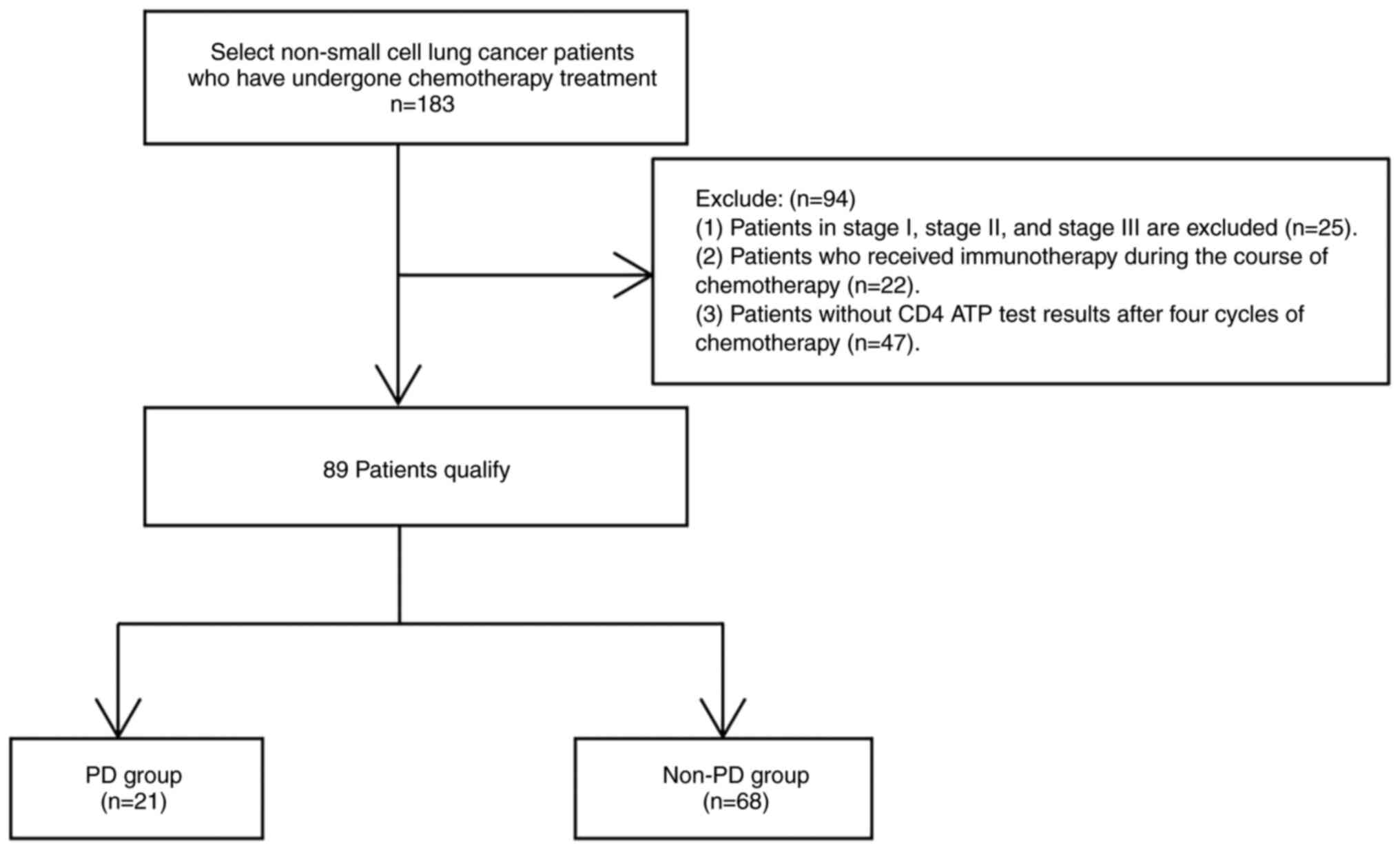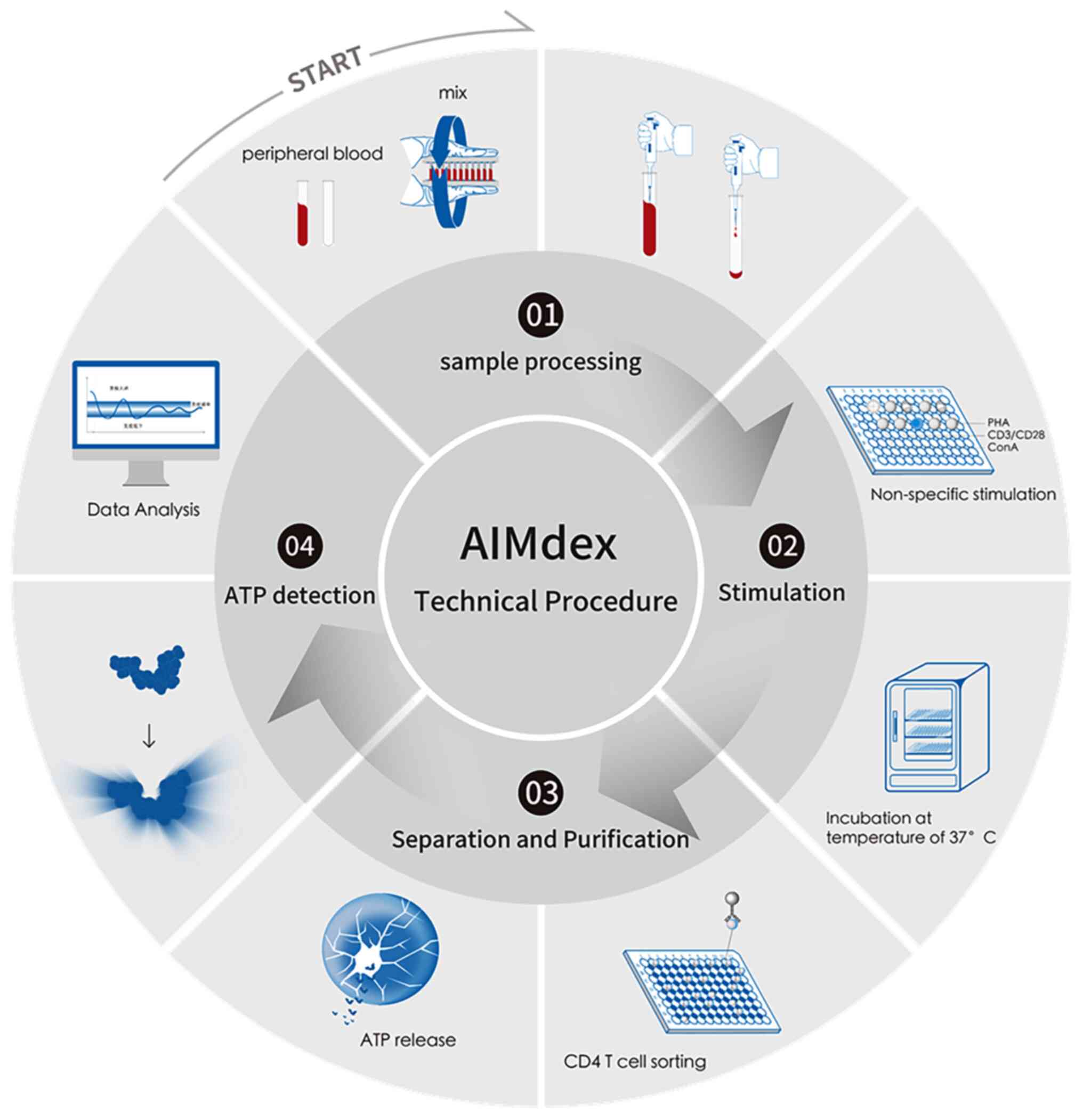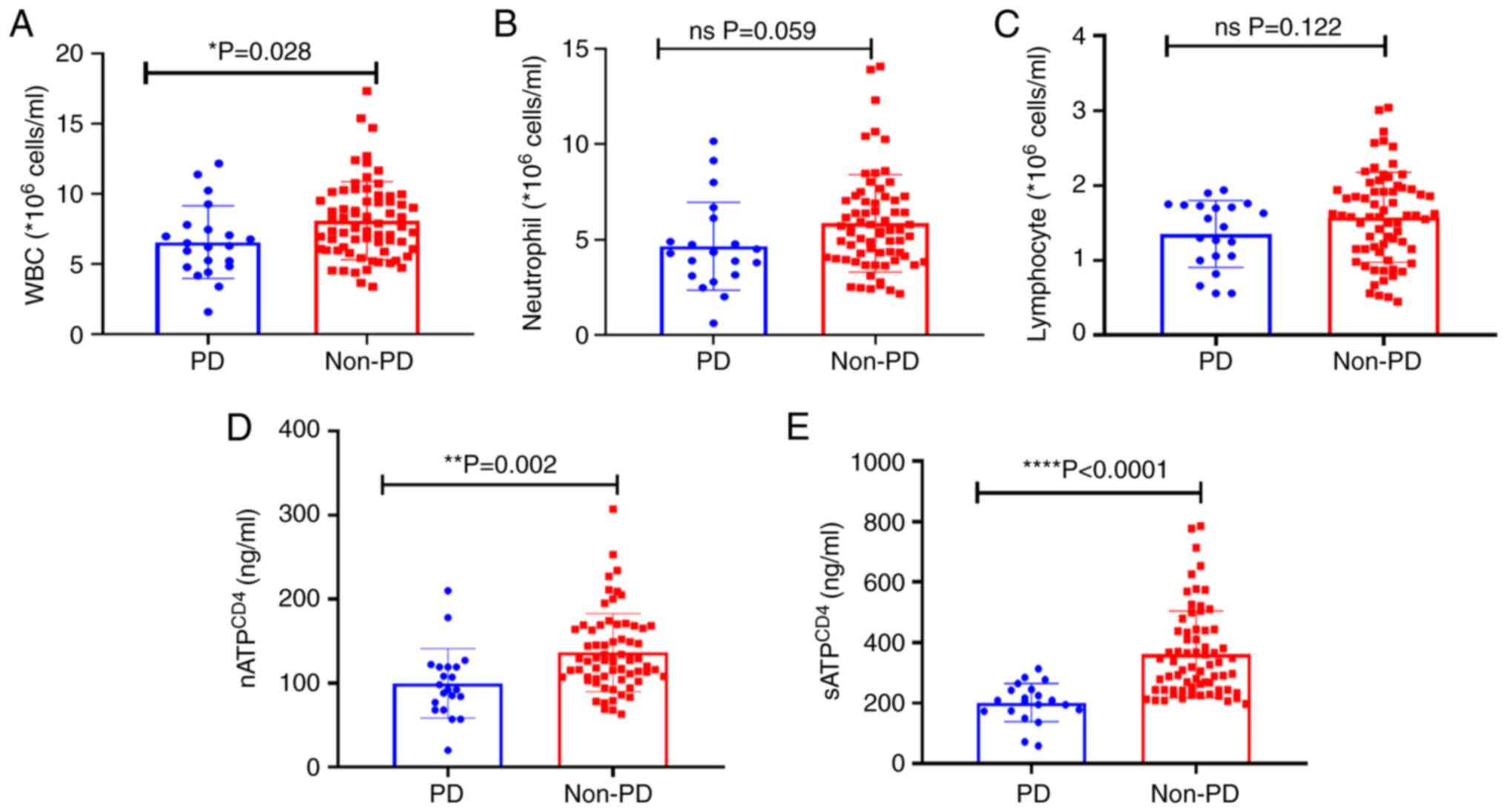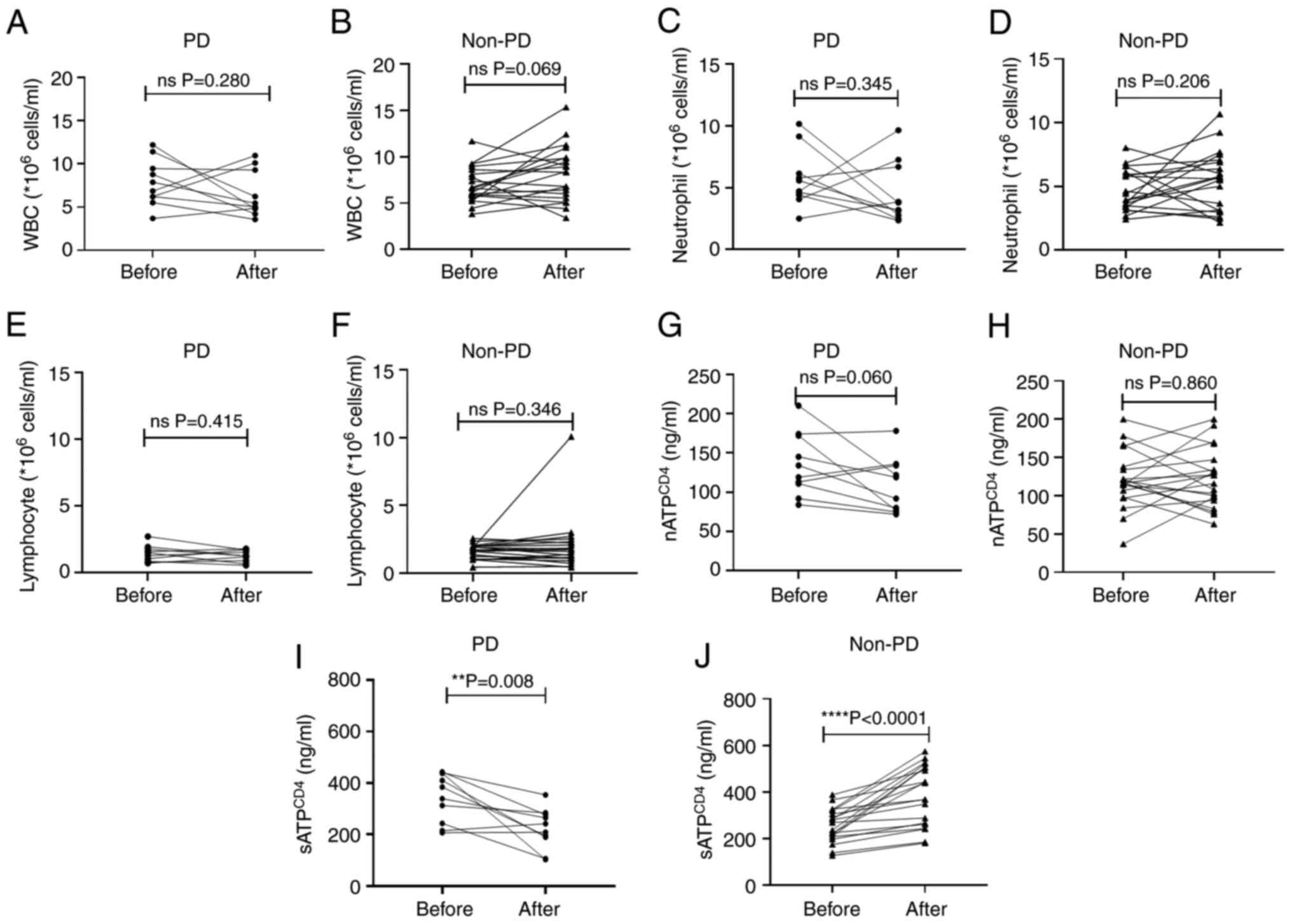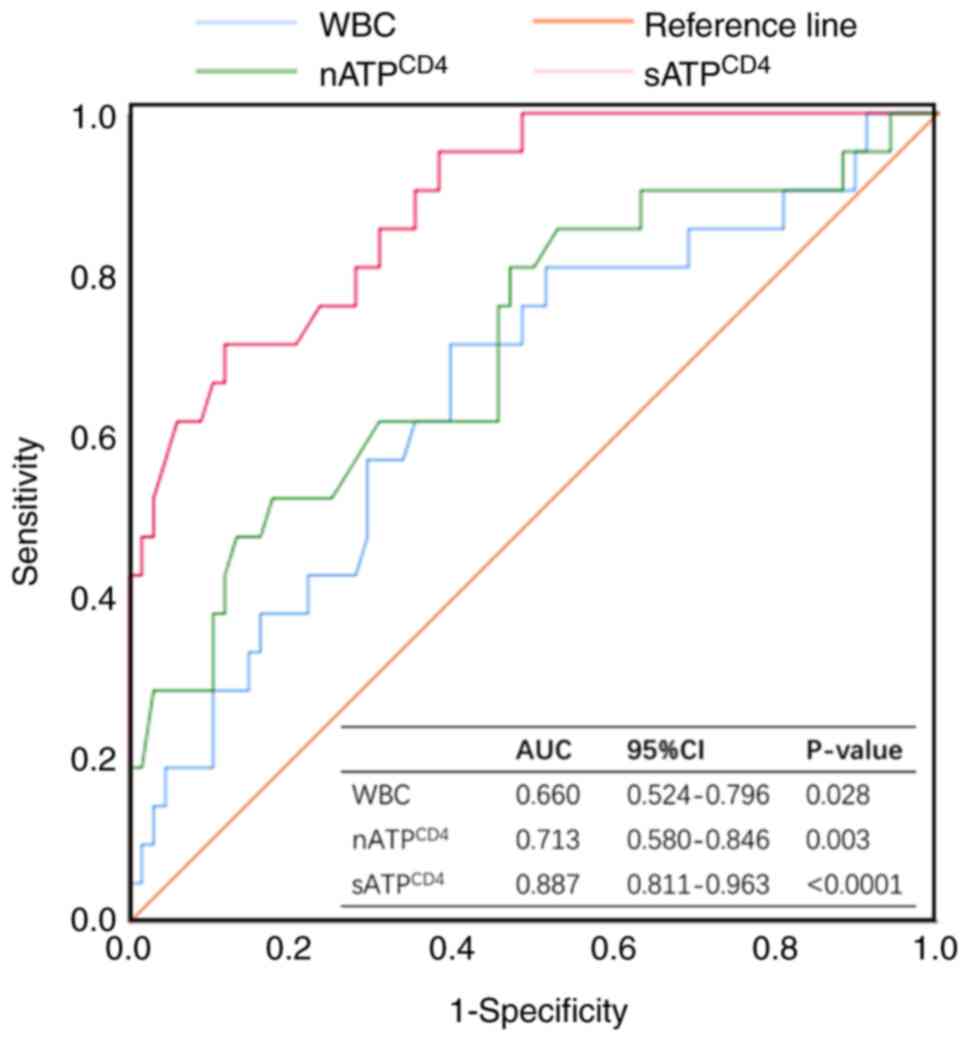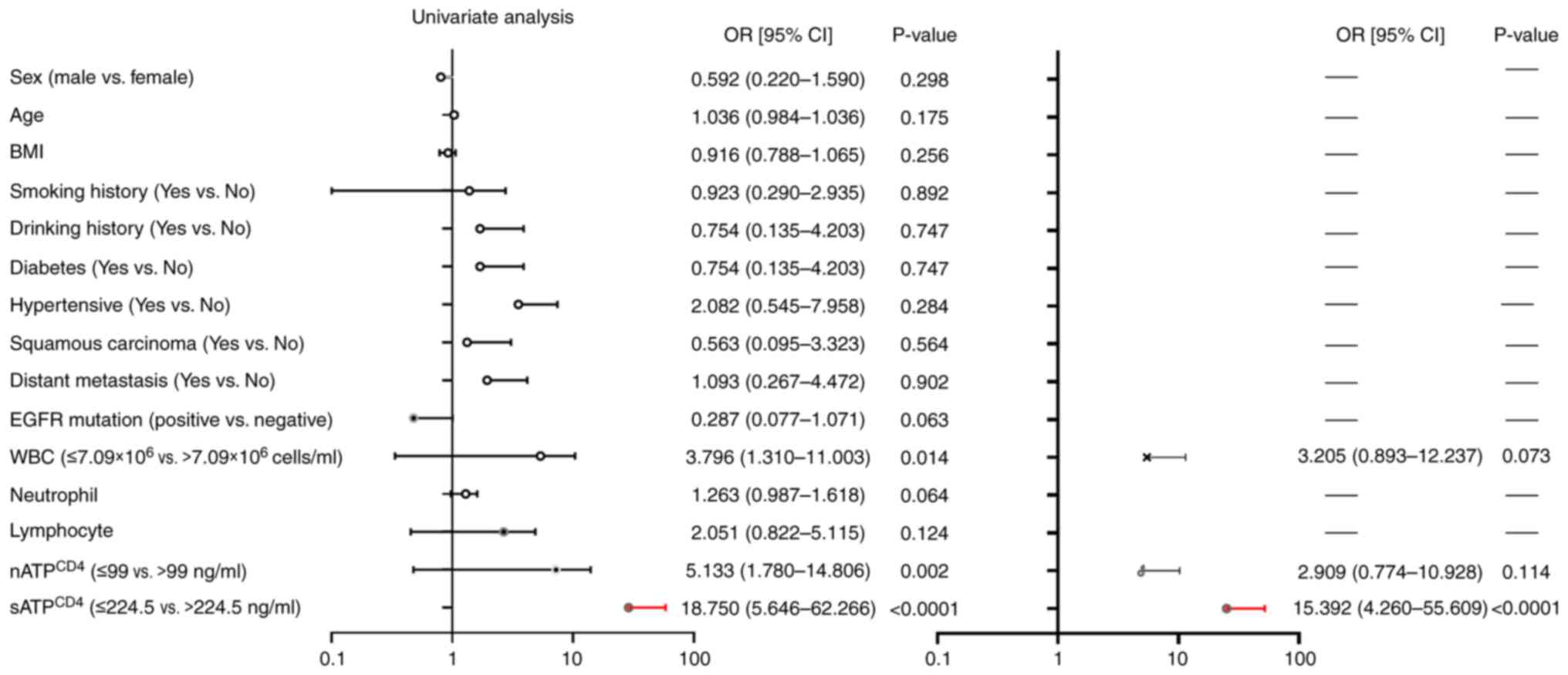Association between CD4+ T cells ATP levels and disease progression in patients with non‑small cell lung cancer
- Authors:
- Published online on: June 12, 2024 https://doi.org/10.3892/ol.2024.14502
- Article Number: 369
-
Copyright: © Ye et al. This is an open access article distributed under the terms of Creative Commons Attribution License.
Abstract
Introduction
Lung cancer, a major factor highly associated with cancer-related mortality worldwide, resulted in 710,000 deaths in China alone, out of 3 million cancer-related fatalities in 2020. Non-small cell lung cancer (NSCLC) is involved in ~80% of these cases (1,2).
Notably, the majority of these patients are diagnosed at an advanced stage of the disease, making them unsuitable candidates for surgical resection. Advanced-stage lung cancer patients are commonly treated with platinum-based chemotherapy regimens, which exert favorable efficacy (3). However, in addition to the therapeutic benefits of platinum-based regimens, attention should be also paid to their hematologic and gastrointestinal toxicities, which can potentially significantly compromise the patient's immune function and treatment outcomes (4). According to the cancer immunoediting theory, including immune elimination, homeostasis and escape, indicates that immunity is closely associated with the occurrence and progression of cancer (5). Therefore, assessing and improving the immune function of late-stage patients with NSCLC following chemotherapy has become a clinical concern.
Previous studies indicated that compared with healthy individuals, patients with lung cancer exhibited lower count of CD4+ T and NK cells and reduced CD4+/CD8+ ratios, accompanied by elevated number of regulatory T cells (Tregs) (6,7). Additionally, another study showed that patients with NSCLC, who responded effectively to immunotherapy, experienced an increase in the proportion of CD4+ T cells compared with the baseline values, while no statistically significant changes were observed in the ineffective response group (8). Furthermore, previous studies also demonstrated that chemotherapy drugs could impair the proliferation and function of peripheral circulating effector T cells, thus potentially leading to the reduced proliferative activity of cytotoxic T lymphocytes (CTLs) (9,10). However, it has been also reported that chemotherapy drugs can induce tumor cell apoptosis, which in turn trigger immune responses, eventually enhancing the cytotoxicity of CTLs and strengthening anti-tumor immunity (11). Chemotherapy drugs can also accelerate CD4+CD25+ Treg apoptosis, thus reducing the number of Tregs and effectively regulating tumor immunity (12). In summary, there is no consensus regarding the effect of chemotherapy on the immune function of patients with cancer and the immune status on chemotherapy outcome. Therefore, more research and immune function assessment methods are needed to establish a conclusive understanding.
The CD4+ T cell adenosine triphosphate (ATP) release assay is used to measure intracellular ATP concentration within purified CD4+ T lymphocytes following stimulation with phytohemagglutinin-L. This assay is used to assess peripheral immune function and emerging evidence suggests that it has significant predictive value in predicting post-transplant infections in organ transplant recipients and hematopoietic stem cell recipients, as well as septic shock in septic patients (13–17).
Some researchers have found that patients who developed septic shock had markedly lower CD4+ T cell ATP levels compared with septic patients who did not shock. However, there were no significant differences in the percentages of CD4+ and CD8+ T lymphocytes between the two groups (17), Additionally, Serban et al (16) conducted a study showed that patients with decreased CD4+ T cell ATP levels five months after allogeneic transplantation had a higher risk of infection, while CD4+ T cell counts remained at an increased level (16), This indicates that for patients with similar immune cell quantities and poorer health status sATPCD4 holds a special clinical value. Clinical trials have been conducted to evaluate CD4+ T cells ATP release levels in hepatocellular carcinoma, thus revealing a close association between progression-free survival (PFS), overall survival (OS) and cancer recurrence (18,19). Tumor initiation and progression are intricately associated with the host immune function. Tumor immunity represents a dynamic process, where T cell responses are enhanced. Therefore, maintaining adequate immune function is crucial for fostering a beneficial cycle (20). However, to the best of our knowledge, the association between CD4+ T cells ATP levels and NSCLC progression has not been previously investigated. Therefore, exploring the association between CD4+ T cells ATP release levels and NSCLC holds potential value in understanding the interplay between immune function and NSCLC progression.
The present study aimed to evaluate the changes in immune function prior and after chemotherapy, as well as the association between post-chemotherapy immune status and tumor progression.
Materials and methods
Patients
Patients diagnosed with NSCLC, who were treated with chemotherapy, were retrospectively reviewed between August 15 2022 and August 30 2023, at the Fifth Affiliated Hospital of Guangzhou Medical University Hospital, Guangzhou, China (n=183). Among a total of 183 patients, 89 patients were screened and allocated into the disease progression (PD, n=21) and disease stability (non-PD; n=68; Fig. 1) groups, males accounted for 52.8% of the population, with patient ages ranging from 33 to 78 years (mean age 66.2±10.2). A total of 10 and 20 patients in the PD and non-PD groups, respectively, underwent immunocellular function assay before chemotherapy. The present study received approval from the Ethics Committee of the Fifth Affiliated Hospital of Guangzhou Medical University (Guangzhou, China) dated 08-07-2022 of and approval no. KY01-2022-07-08. Written informed consent was obtained from all participants, allowing the use of their clinical data in this study. The research adhered to the principles outlined in the Declaration of Helsinki.
Inclusion and exclusion criteria
The inclusion criteria were as follows: i) Patients with pathological diagnosis of NSCLC; ii) with locally advanced disease, medically or technically inoperable; iii) those treated with periodic chemotherapy (pemetrexed, cisplatin, carboplatin, paclitaxel, gemcitabine); iv) with Eastern Cooperative Oncology Group (ECOG) score of 0–2 (ECOG score 0: Normal activity without symptoms, fully active and able to carry on all pre-disease performance without restriction; ECOG score 1: Symptomatic, but completely ambulatory, restricted in physically strenuous activity, but able to perform light or sedentary work; ECOG score 2: Symptomatic, in bed <50% of waking hours and capable of limited self-care and confined to bed or chair >50% of waking hours) (21). Patients were staged according to the 8th edition TNM staging system (22). The exclusion criteria were the followings: i) Patients with stage I, II or III NSCLC; ii) those who were treated with immunotherapy; iii) HIV-positive individuals; and iv) those whose ATP release levels from CD4+ T lymphocytes were not recorded after four cycles of chemotherapy. The study conformed to the principles outlined in the Declaration of Helsinki (approval no. KY01-2022-07-08).
Study assessment
Neck, chest, whole abdomen and pelvic computed tomography (CT) imaging examinations were conducted prior to initial treatment and at 20 days following the completion of four cycles of treatment. Treatment efficacy was evaluated according to the Response Evaluation Criteria for Solid Tumors (RECIST) 1.1 criteria (23) and categorized as PR (partial response), SD (stable disease) or PD. Patients who were treated with chemotherapy for four cycles and had no progression at two consecutive radiological assessments were allocated into the non-PD group (PR + SD), while those who did not meet the aforementioned criteria were included in the PD group. The current analysis was performed to assess the association between peripheral blood CD4+T cells ATP expression and treatment efficacy after four cycles of therapy.
Immunocellular function assay
The levels of ATP released by stimulated (sATPCD4) and non-stimulated (nATPCD4) CD4 T lymphocytes were assessed through a luciferin-luciferase reaction, according to the manufacturer's instructions (AIMdex®; Leide Biosciences Co., Ltd.) (24). Briefly, 100 µl of 4-fold diluted whole blood was incubated with 8.75 ng/ml sATP or without phytohaemagglutinin (PHA; nATP) for 15–18 h,37°C. CD4+ T cells were isolated using magnetic beads (900-1, 100 µg/well; Leide Biosciences Co., Ltd.) and ATP was released using a lysis buffer. Subsequently, the mixture was supplemented with luciferin/luciferase and bioluminescence was measured using a luminometer (JR-I; Weihai Weigao Biotechnology Co., Ltd). The results were analyzed using the corresponding software (JR-1 v2.3.8.8.181120/1.2.0; Weihai Weigao Biotechnology Co., Ltd). A standard curve with ATP calibrators (0, 50, 100, 200, 400 and 800 ng/ml) was constructed. ATP release was determined by comparing ATP levels between CD4+T cell- stimulated and non-stimulated samples (Fig. 2) and validated through clinical repeatability assessment, meeting clinical standards.
Blood parameter assessment
White blood cell (WBC), granulocyte and lymphocyte counts were measured using a fully automated hematology analyzer (Original Mindray BC-5180 CRP; Mindray).
Treatment and data collection
The relevant clinical and laboratory data were collected from the electronic medical records system. The clinical characteristics of patients, such as age, sex, smoking and drinking history, underlying medical conditions and histology were collected and summarized (Table I). Baseline measurements were defined as those after chemotherapy.
Statistical analysis
All statistical analyses were performed using SPSS 26.0 software (IBM Corp.). The clinical and demographic data are expressed as the mean ± standard deviation (SD) or medians [interquartile ranges (IQRs)] for continuous variables, depending on their distribution (normally and non-normally distributed). Categorical variables are expressed as percentages. The differences between categorical, normally distributed and non-normally distributed continuous variables were compared using chi-square, Student's t-test (Between-group comparisons were performed using independent t-tests, while within-group comparisons before and after treatment were conducted using paired t-tests) and Mann-Whitney U test, respectively. The association between peripheral blood biomarkers and PD was assessed by logistic regression analysis, while the predictive values of the baseline peripheral blood parameters were evaluated using receiver operating characteristics (ROC) curves. In addition, the optimal cut-off values were determined using the Youden's index, which was calculated using the following formula: Youden's index=Sensitivity + Specificity-1. The maximum Youden's index value was considered to indicate the optimal cut-off point. The differences in area under the curve (AUC) values were analyzed using DeLong test. All graphs were generated using GraphPad Prism 8.0 software (Dotmatics).
Results
Patient characteristics
In the present study, a total of 89 patients were allocated into the non-PD (n=68; including three PR and 65 SD cases) and PD (n=21 cases) groups. The baseline characteristics of patients are summarized in Table I. No significant differences were recorded in terms of sex (P=0.296; χ2=1.092), age (P=0.174; Z=0.119), body mass index (BMI; P=0.258; t=1.178), smoking history (P=0.867; χ2=0.028), drinking history (P=0.747; χ2=0.104), diabetes (P=0.747; χ2=0.104), hypertensive (P=0.304; χ2=1.057), histology (P=0.561; χ2=0.228), distant metastasis (P=0.962; χ2=0.002), EGFR mutation status (P=0.052; χ2=3.760), treatment regimen (P=0.829; χ2=0.884) and chemotherapy regimen (P=0.125; χ2=4.160) between the PD and non-PD groups.
Comparison of peripheral blood indicators between the PD and non-PD groups
Peripheral blood indicators were compared between the PD and non-PD groups (Fig. 3). The analysis revealed a significant reduction in WBC count (P=0.028; Fig. 3A) and nATPCD4 (P=0.002; Fig. 3D) and sATPCD4 (P<0.001; Fig. 3E) levels between the PD and non-PD groups (Fig. 3A). Additionally, a slight decrease in neutrophil (P=0.059; Fig. 3B) and lymphocyte counts (P=0.122; Fig. 3C) was also recorded.
Changes in the peripheral blood indicators after chemotherapy
To comprehensively assess the alterations in peripheral blood indicators following chemotherapy, the levels of the relevant indicators prior and after four cycles of treatment were compared. Data from both the pre- and post-treatment periods were available for 10 PD and 20 non-PD cases. No significant changes in WBC, neutrophil and lymphocyte counts and nATPCD4 levels were obtained after chemotherapy in both the PD and non-PD groups (P>0.05; Fig. 4A-H). However, sATPCD4 levels were notably reduced in the PD group after chemotherapy (P=0.008; Fig 4I), while they were significantly enhanced in the non-PD group (P<0.0001; Fig 4J).
Cut-off points and association with the occurrence of PD
The diagnostic efficacy of WBC, nATPCD4 and sATPCD4 after four treatment cycles was assessed by ROC curves (Fig. 5). For sATPCD4, a cut-off value of 224.5 ng/ml [AUC=0.887; 95% confidence interval (CI), 0.811–0.963; specificity 88.2%, sensitivity 71.4%] displayed the highest sensitivity and specificity for PD diagnosis. Consistently, cut-off values of 99 ng/ml (AUC=0.713; 95% CI, 0.580–0.846; specificity 82.4%, sensitivity 52.4%) and 7.09×109 cells/l (AUC=0.660; 95% CI, 0.524–0.796; specificity 60.3%, sensitivity 71.4%) were obtained for nATPCD4 and WBC, respectively. The AUC value for sATPCD4 was significantly higher compared with that for nATPCD4 (P=0.010) and WBC (P=0.001; Table II).
Table II.Paired-sample area differences under the receiver operating characteristics curves for sATPCD4, nATPCD4 and WBC. |
Analysis of risk factors associated with the occurrence of PD
Univariate and multivariate logistic regression analyses were performed to explore the association between measured variables and PD occurrence. In univariate analysis, WBC count (OR=3.796; 95% CI, 1.310–11.003; P=0.014) and nATPCD4 (OR=5.133; 95% CI, 1.780–14.806; P=0.002) and sATPCD4 (OR=18.750; 95% CI, 5.646–62.266; P<0.0001) levels were significantly associated with the occurrence of PD. However, no significant association was recorded for other factors. After adjusting for confounders, namely WBC count and nATPCD4 and sATPCD4 levels, patients with low sATPCD4 levels (<224.5 ng/ml) displayed a 15-fold higher risk of PD compared with those with high sATPCD4 levels (≥224.5 ng/ml; OR=15.392; 95% CI, 4.260–55.609; P<0.0001; Fig. 6).
Discussion
The treatment of NSCLC continues to face challenges. Notably, several multiplexed detection methods, based on an optimized nanoparticle-based laser desorption/ionization mass spectrometry platform, have been developed. This treatment approach is considered as an effective tool for the screening of patients with NSCLC, potentially allowing the early diagnosis of a greater number of patients with lung cancer (25). However, for patients with advanced-stage lung cancer, chemotherapy remains a critical treatment modality. Chemotherapy efficacy is a pivotal concern in the treatment of various malignancies, since it directly affects patient outcomes and OS. However, PD remains the leading clinical problem (26,27). The current study aimed to identify factors associated with PD in patients with NSCLC undergoing chemotherapy.
The potential of immune-related biomarkers, including N6-methyladenosine and immune-related lncRNAs, in predicting immunotherapy response in lung squamous cell carcinoma via delineating molecular subtypes with varying treatment efficacy has been recently underlined (28). However, their applicability in predicting chemotherapy response has not been previously investigated. A previous study emphasized the significance of the tumor microenvironment in the context of cancer chemotherapy (29). Nevertheless, it has been suggested that the immune microenvironment status within the tumor site and the overall systemic immune profiles of patients with cancer prior to treatment can affect their response to chemotherapy (30). The association between peripheral blood-related immunological markers, including lower peripheral blood mononuclear cell counts and diminished cytokine expression levels and inferior treatment responses has been widely investigated (31,32). Considering the aforementioned findings, in the present study, a comparative analysis of routine peripheral blood parameters, including WBC, neutrophil and lymphocyte counts, between the PD (n=21) and non-PD groups (n=68) was performed. The results revealed that WBC counts were notably reduced in patients in the PD group compared with those in the non-PD group, with relatively stable disease status (P=0.028).
The present study unveiled new possibilities for exploiting ATP detection as a sensitive and specific biomarker for predicting disease progression. The majority of cellular functions depend on ATP production and therefore intracellular ATP synthesis serves as a marker of cell activity (33). In a previous study, Cylex's Immuknow assay was used to evaluate the activity of CD4+ T lymphocytes (34). Assessing the activity of CD4+ T lymphocytes in the peripheral blood of organ transplant recipients can enable the early identification of potential risks associated with rejection and infection (35). Previous studies in sepsis revealed that sATPCD4 levels were markedly enhanced among survivors compared with non-survivors within the first day of intensive care unit admission (13,36). The aforementioned divergent findings highlight the complex nature of sATPCD4 and its potential roles in several diseases. The current study revealed a noteworthy decline in sATPCD4 levels within the PD group following chemotherapy. Intriguingly, a notable increase in sATPCD4 levels was observed in the non-PD group, characterized by stable disease status (Fig. 4). Furthermore, both nATPCD4 and sATPCD4 levels were significantly diminished in patients experiencing PD compared with the non-PD group (P=0.002; P<0.0001; Fig. 3). These results supported the ability of ATP to mirror the effect of chemotherapy on immune function in NSCLC.
As a crucial factor of anti-tumor immunity, peripheral blood CD4+ T cells play a pivotal role in regulating and enhancing the priming, migratory potential and killing activity of CTLs (37). In the present study, ROC curve analysis demonstrated a superior discriminatory ability for sATPCD4, as evidenced by its higher AUC value (0.887) compared with that obtained for WBC (AUC=0.660) and nATPCD4 (AUC=0.713). Employing a designated cut-off value of 224.5 ng/ml for sATPCD4, the sensitivity and specificity were estimated to be 77.4 and 88.2%, respectively (Fig. 5). Notably, sATPCD4 levels <224 ng/ml were indicative of an elevated risk of PD, thus underscoring a robust association between CD4+ T cell immune function and patient prognosis. Low ATP levels indicate a state of immunosuppression, thus accelerating tumor progression via the intricate immunosuppressive network established by interactions between cancer cells and host immune cells. This phenomenon could promote tumor growth, while simultaneously providing a shield against immune attacks, thus contributing to the complex dynamics of cancer progression (38). It has been reported that during the complex immune editing process, where several CD4+ T cell subsets play significant roles in both tumor promotion and rejection, sATPCD4 serves as a valuable indicator reflecting the overall net status of immune activity (35).
Factors that affect treatment efficacy in patients with NSCLC include lymphocyte subpopulations (39,40), treatment regimen (41,42) and gene mutations (42,43). The results of the present study showed that only sATPCD4 was a risk factor for tumor progression. This finding could be associated with the small sample size. The results of the current study were consistent with those reported in liver cancer, demonstrating that patients with low sATPCD4 levels exhibited markedly lower PFS and OS compared with those in the high ATP group (18). Another study also suggested that adjusting the dosage of immunosuppressive agents based on ATP levels could markedly improve the OS and reduce infection rates in liver transplant patients (44). The present study and previous studies demonstrated that sATPCD4 levels could reflect immune function in patients with cancer and were associated with treatment efficacy and prognosis. However, the mechanism underlying the effect of sATPCD4 levels on reflecting the efficacy of chemotherapy remains to be elucidated.
In the present study, the particular underlying mechanism was investigated, which could be associated with how chemotherapy could promote the death of tumor cells within a short period. In turn, the death of tumor cells induces the release of several tumor antigens, potentially stimulating antigen-presenting cells to present tumor antigens to T cells, thus promoting T cell activation and proliferation (20). Additionally, the combination of EGFR-targeted agents could enhance the presentation of MHC I-class tumor antigens to facilitate the uptake of tumor material by dendritic cells and promote T cell activation in the absence of additional immune stimulation signals (45). Activated T cells infiltrate tumor tissues and attack antigen-expressing tumor cells. Furthermore, emerging evidence has suggested that cellular metabolism plays a critical role in T cell differentiation and function. Changes in the metabolic activity of T cells can directly affect their function and survival, which is reflected in ATP expression levels (46). Therefore, higher nATPCD4 and sATPCD4 expression levels were observed in patients with disease stabilization or remission following chemotherapy. Conversely, in patients with PD, chemotherapy drugs could not only promote tumor cell injury, but they could also harm normal immune cells, thus resulting in impaired immune function. The aforementioned processes could be accompanied by lower nATPCD4 and sATPCD4 expression levels. Consequently, the immune cells of these patients could fail to effectively clear tumor cells, thus leading to PD.
However, the present study had several limitations. First, the relatively small sample size and limited number of events, as well as the fact that it was conducted only on Chinese individuals without validation in other ethnic backgrounds, constrained comprehensive multivariable analysis. Additionally, an increasing number of studies have demonstrated that advanced NSCLC patients with KRAS mutations exhibit markedly lower objective response rate and potentially lower 6-month/1-year PFS rates compared with wild-type patients after first-line chemotherapy (43,47,48). However, the limited number of cases with detected KRAS mutations in this study (Table I) precludes the calculation of whether KRAS gene mutations affect chemotherapy efficacy. Whether KRAS mutations serve as risk factors for sATPCD4 requires further investigation. Therefore, further validation of the results is needed to draw definitive conclusions. Additionally, the retrospective and single-center nature of this study may introduce some bias, potentially resulting in inherent deviations. Considering the primary goals of immunotherapy, extending the observation period, treatment cycles and longitudinally monitoring changes in sATPCD4 subsets are crucial for investigating their association with OS and PFS.
In summary, in the present study a noteworthy association between low nATPCD4 and sATPCD4 levels and tumor progression was observed in patients with advanced NSCLC treated with chemotherapy. These findings could assist physicians in assessing immune function to clearly determine the immunological status of patients with cancer, thus tailoring treatment strategies to prevent disease progression. The current study was the first to provide such findings, to the best of the authors' knowledge. However, further prospective and multicenter studies with larger sample sizes are needed to validate the aforementioned results.
The present study suggested that sATPCD4 levels could serve as an indicator of the effect of chemotherapy on immune function and holds promise for assessing the potential risk of disease progression in patients with NSCLC.
Acknowledgements
The authors would like to thank Ms. Juanjuan Peng and Ms. Hongxia Wei (Leide Biosciences Co., Ltd.) for their technical guidance.
Funding
The present study was supported by the Guangzhou Characteristic Technology Project (grant no. 2023C-TS29); and the Research Project of Guangzhou Science and Technology Bureau (grant no. 202201010787).
Availability of data and materials
The data generated in the present study may be requested from the corresponding author.
Authors' contributions
WY, KH, NT, WL, ZT, QH, DY, HL, ZD, YX and GY contributed to the study conception and design. Material preparation, data collection and analysis were performed by WY, KH and NT under supervision of GY. The first draft of the manuscript was written by WY. KH and NT confirm the authenticity of all the raw data. WL, ZT and QH reviewed and revised the first draft, conducted domestic and international literature searches for the discussion section and improved the discussion section. DY and HL further reviewed and examined the data analysis and graphics production in the article. ZD and YX formatted the final version of the article. GY supervised the entire experiment and performed the final review of the article. All authors read and approved the final manuscript.
Ethics approval and consent to participate
The present study received approval from the Ethics Committee of the Fifth Affiliated Hospital of Guangzhou Medical University (Guangzhou, China; dated 08-07-2022; approval no. KY01-2022-07-08). Written informed consent was obtained from all participants, allowing the use of their clinical data in this study. The research adhered to the principles outlined in The Declaration of Helsinki.
Patient consent for publication
Not applicable.
Competing interests
The authors declare that they have no competing interests.
References
|
Siegel RL, Miller KD, Wagle NS and Jemal A: Cancer statistics, 2023. CA Cancer J Clin. 73:17–48. 2023. View Article : Google Scholar : PubMed/NCBI | |
|
Xia C, Dong X, Li H, Cao M, Sun D, He S, Yang F, Yan X, Zhang S, Li N and Chen W: Cancer statistics in China and United States, 2022: Profiles, trends, and determinants. Chin Med J (Engl). 135:584–590. 2022. View Article : Google Scholar : PubMed/NCBI | |
|
Chen X, Liu Y, Røe OD, Qian Y, Guo R, Zhu L, Yin Y and Shu Y: Gefitinib or erlotinib as maintenance therapy in patients with advanced stage non-small cell lung cancer: A systematic review. PLoS One. 8:e593142013. View Article : Google Scholar : PubMed/NCBI | |
|
Li K, Zhang Q, Zhang Y, Yang J and Zheng J: T-cell-associated cellular immunotherapy for lung cancer. J Cancer Res Clin Oncol. 141:1249–1258. 2015. View Article : Google Scholar : PubMed/NCBI | |
|
Carlisle JW, Steuer CE, Owonikoko TK and Saba NF: An update on the immune landscape in lung and head and neck cancers. CA Cancer J Clin. 70:505–517. 2020. View Article : Google Scholar : PubMed/NCBI | |
|
Mazzaschi G, Facchinetti F, Missale G, Canetti D, Madeddu D, Zecca A, Veneziani M, Gelsomino F, Goldoni M, Buti S, et al: The circulating pool of functionally competent NK and CD8+ cells predicts the outcome of anti-PD1 treatment in advanced NSCLC. Lung Cancer. 127:153–163. 2019. View Article : Google Scholar : PubMed/NCBI | |
|
Kotsakis A, Koinis F, Katsarou A, Gioulbasani M, Aggouraki D, Kentepozidis N, Georgoulias V and Vetsika EK: Prognostic value of circulating regulatory T cell subsets in untreated non-small cell lung cancer patients. Sci Rep. 6:392472016. View Article : Google Scholar : PubMed/NCBI | |
|
Yan Y, Wang X, Liu C and Jia J: Association of lymphocyte subsets with efficacy and prognosis of immune checkpoint inhibitor therapy in advanced non-small cell lung carcinoma: A retrospective study. BMC Pulm Med. 22:1662022. View Article : Google Scholar : PubMed/NCBI | |
|
Robaire B and Hales BF: Mechanisms of action of cyclophosphamide as a male-mediated developmental toxicant. Adv Exp Med Biol. 518:169–180. 2003. View Article : Google Scholar : PubMed/NCBI | |
|
Vollmer T, Stewart T and Baxter N: Mitoxantrone and cytotoxic drugs' mechanisms of action. Neurology. 74:S41–S46. 2010. View Article : Google Scholar : PubMed/NCBI | |
|
Hodge JW, Garnett CT, Farsaci B, Palena C, Tsang KY, Ferrone S and Gameiro SR: Chemotherapy-induced immunogenic modulation of tumor cells enhances killing by cytotoxic T lymphocytes and is distinct from immunogenic cell death. Int J Cancer. 133:624–636. 2013. View Article : Google Scholar : PubMed/NCBI | |
|
Locher C, Conforti R, Aymeric L, Ma Y, Yamazaki T, Rusakiewicz S, Tesniere A, Ghiringhelli F, Apetoh L, Morel Y, et al: Desirable cell death during anticancer chemotherapy. Ann N Y Acad Sci. 1209:99–108. 2010. View Article : Google Scholar : PubMed/NCBI | |
|
Xue F, Gao W, Qin T, Wu C, Luo Y, Chen J, Zhou T, Feng M, Qiu B, Zhu J, et al: Immune cell function assays in the diagnosis of infection in pediatric liver transplantation: An open-labeled, two center prospective cohort study. Transl Pediatr. 10:333–343. 2021. View Article : Google Scholar : PubMed/NCBI | |
|
Liu W, Wang K, Zhao YH, Song GP, Gao W and Li DH: Clinical relevance of a CD4+ T cell immune function assay in the diagnosis of infection in pediatric living-donor liver transplantation. Exp Ther Med. 18:3823–3828. 2019.PubMed/NCBI | |
|
Maidman SD, Gidea C, Reyentovich A, Rao S, Saraon T, Kadosh BS, Narula N, Carillo J, Smith D, Moazami N, et al: Pre-transplant immune cell function assay as a predictor of early cardiac allograft rejection. Clin Transplant. 36:e147452022. View Article : Google Scholar : PubMed/NCBI | |
|
Serban G, Whittaker V, Fan J, Liu Z, Manga K, Khan M, Kontogianni K, Padmanabhan A, Cohen D, Suciu-Foca N, et al: Significance of immune cell function monitoring in renal transplantation after Thymoglobulin induction therapy. Hum Immunol. 70:882–890. 2009. View Article : Google Scholar : PubMed/NCBI | |
|
Xian Y, Zhang KX, Bi XG, Zheng CL and Xie D: Value of adenosine triphosphate in CD4+ T lymphocytes to the prediction of prognosis of septic patients. Chin Pract Diagn Ther. 37:1216–1221. 2023.(In Chinese). | |
|
Cheng JW, Shi YH, Fan J, Huang XW, Qiu SJ, Xiao YS, Wang Z, Dai Z, Tang ZY and Zhou J: An immune function assay predicts post-transplant recurrence in patients with hepatocellular carcinoma. J Cancer Res Clin Oncol. 137:1445–1453. 2011. View Article : Google Scholar : PubMed/NCBI | |
|
Uemura T, Riley TR, Khan A, Hollenbeak C, Schreibman I, Ghahramani N, Reeves B, Domen RE, Zander DS and Kadry Z: Immune functional assay for immunosuppressive management in post-transplant malignancy. Clin Transplant. 25:E32–E37. 2011. View Article : Google Scholar : PubMed/NCBI | |
|
Chen DS and Mellman I: Oncology meets immunology: The cancer-immunity cycle. Immunity. 39:1–10. 2013. View Article : Google Scholar : PubMed/NCBI | |
|
Gridelli C, Ardizzoni A, Le Chevalier T, Manegold C, Perrone F, Thatcher N, Van Zandwijk N, Di Maio M, Martelli O and De Marinis F: Treatment of advanced non-small-cell lung cancer patients with ECOG performance status 2: Results of an European experts panel. Ann Oncol. 15:419–426. 2004. View Article : Google Scholar : PubMed/NCBI | |
|
Detterbeck FC, Chansky K, Groome P, Bolejack V, Crowley J, Shemanski L, Kennedy C, Krasnik M, Peake M and Rami-Porta R: IASLC Staging and Prognostic Factors Committee, Advisory Boards, and Participating Institutions: The IASLC lung cancer staging project: Methodology and validation used in the development of proposals for revision of the stage classification of NSCLC in the forthcoming (eighth) edition of the TNM classification of lung cancer. J Thorac Oncol. 11:1433–1446. 2016. View Article : Google Scholar : PubMed/NCBI | |
|
Seymour L, Bogaerts J, Perrone A, Ford R, Schwartz LH, Mandrekar S, Lin NU, Litière S, Dancey J, Chen A, et al: iRECIST: Guidelines for response criteria for use in trials testing immunotherapeutics. Lancet Oncol. 18:e143–e152. 2017. View Article : Google Scholar : PubMed/NCBI | |
|
Hou K, Ye W, Huang Q, Li W, Tan Z, Tao N, Yang D, Lin H, Deng Z, Xia Y and Yu G: The predictive value of peripheral blood CD4 cells ATP concentration for immune-related adverse events in advanced non-small cell lung cancer patients. BMC Immunol. 25:32024. View Article : Google Scholar : PubMed/NCBI | |
|
Wang L, Zhang M, Pan X, Zhao M, Huang L, Hu X, Wang X, Qiao L, Guo Q, Xu W, et al: Integrative serum metabolic fingerprints based multi-modal platforms for lung adenocarcinoma early detection and pulmonary nodule classification. Adv Sci (Weinh). 9:e22037862022. View Article : Google Scholar : PubMed/NCBI | |
|
Griesinger F, Korol EE, Kayaniyil S, Varol N, Ebner T and Goring SM: Efficacy and safety of first-line carboplatin-versus cisplatin-based chemotherapy for non-small cell lung cancer: A meta-analysis. Lung Cancer. 135:196–204. 2019. View Article : Google Scholar : PubMed/NCBI | |
|
Chalabi M, Cardona A, Nagarkar D, Scala AD, Gandara D, Rittmeyer A, Albert M, Powles T, Kok M and Herrera FG; imCORE working group of early career investigators, : Efficacy of chemotherapy and atezolizumab in patients with non-small-cell lung cancer receiving antibiotics and proton pump inhibitors: Pooled post hoc analyses of the OAK and POPLAR trials. Ann Oncol. 31:525–531. 2020. View Article : Google Scholar : PubMed/NCBI | |
|
Ding Z, Liu Y, Huang Q, Cheng C, Song L, Zhang C, Cui X, Wang Y, Han Y and Zhang H: m6A-and immune-related lncRNA signature confers robust predictive power for immune efficacy in lung squamous cell carcinoma. View. 4:202200832023. View Article : Google Scholar | |
|
Hanoteau A, Newton JM, Krupar R, Huang C, Liu HC, Gaspero A, Gartrell RD, Saenger YM, Hart TD, Santegoets SJ, et al: Tumor microenvironment modulation enhances immunologic benefit of chemoradiotherapy. J Immunother Cancer. 7:102019. View Article : Google Scholar : PubMed/NCBI | |
|
Xu L, Zou C, Zhang S, Chu TSM, Zhang Y, Chen W, Zhao C, Yang L, Xu Z, Dong S, et al: Reshaping the systemic tumor immune environment (STIE) and tumor immune microenvironment (TIME) to enhance immunotherapy efficacy in solid tumors. J Hematol Oncol. 15:872022. View Article : Google Scholar : PubMed/NCBI | |
|
Salem ML, Atia I and Elmashad NM: Higher cytotoxic activities of CD8+ T cells and natural killer cells from peripheral blood of early diagnosed lung cancer patients. BMC Immunology. 24:242023. View Article : Google Scholar : PubMed/NCBI | |
|
Kang DH, Choi SW, Sun P, Chung C, Park D, Lee SI, Koh JS, Kim Y and Lee JE: The rest period between chemotherapy and immunotherapy influences the efficacy of immune checkpoint inhibitors in lung cancer. Thoracic Cancer. 13:2346–2354. 2022. View Article : Google Scholar : PubMed/NCBI | |
|
Bonora M, Patergnani S, Rimessi A, De Marchi E, Suski JM, Bononi A, Giorgi C, Marchi S, Missiroli S, Poletti F, et al: ATP synthesis and storage. Purinergic Signal. 8:343–357. 2012. View Article : Google Scholar : PubMed/NCBI | |
|
Kowalski R, Post D, Schneider MC, Britz J, Thomas J, Deierhoi M, Lobashevsky A, Redfield R, Schweitzer E, Heredia A, et al: Immune cell function testing: An adjunct to therapeutic drug monitoring in transplant patient management. Clin Transplant. 17:77–88. 2003. View Article : Google Scholar : PubMed/NCBI | |
|
Rodrigo E, López-Hoyos M, Corral M, Fábrega E, Fernández-Fresnedo G, Segundo DS, Piñera C and Arias M: ImmuKnow as a diagnostic tool for predicting infection and acute rejection in adult liver transplant recipients: A systematic review and meta-analysis. Liver Transpl. 18:1244–1252. 2012. View Article : Google Scholar | |
|
Lawrence KL, White PH, Morris GP, Jennemann J, Phelan DL, Hotchkiss RS and Kollef MH: CD4+ lymphocyte adenosine triphosphate determination in sepsis: A cohort study. Crit Care. 14:R1102010. View Article : Google Scholar : PubMed/NCBI | |
|
Kagamu H, Kitano S, Yamaguchi O, Yoshimura K, Horimoto K, Kitazawa M, Fukui K, Shiono A, Mouri A, Nishihara F, et al: CD4+ T-cell immunity in the peripheral blood correlates with response to anti-PD-1 therapy. Cancer Immunol Res. 8:334–344. 2020. View Article : Google Scholar : PubMed/NCBI | |
|
Xue F, Zhang J, Han L, Li Q, Xu N, Zhou T, Xi Z, Wu Y and Xia Q: Immune cell functional assay in monitoring of adult liver transplantation recipients with infection. Transplantation. 89:620–626. 2010. View Article : Google Scholar : PubMed/NCBI | |
|
Sun B and Zhang Y: Overview of orchestration of CD4+ T cell subsets in immune responses. Adv Exp Med Biol. 84:1–13. 2014. View Article : Google Scholar : PubMed/NCBI | |
|
Vonderheide RH and Bayne LJ: Inflammatory networks and immune surveillance of pancreatic carcinoma. Curr Opin Immunol. 25:200–205. 2013. View Article : Google Scholar : PubMed/NCBI | |
|
Zhang BB, Zhu W, Tao J, Li Y, Du CC, Chen YX and Liu YD: Short-term efficacy of different first-line chemotherapy regimens for advanced non-small cell lung cancer: A network meta-analysis. Clin Trans Sci. 13:589–598. 2020. View Article : Google Scholar | |
|
Xu J, Xiong Y, Xu Z, Xing H, Zhou L and Zhang X: From targeted therapy to a novel way: Immunogenic cell death in lung cancer. Front Med (Lausanne). 9:11025502022. View Article : Google Scholar : PubMed/NCBI | |
|
Hamarsheh SA, Groß O, Brummer T and Zeiser R: Immune modulatory effects of oncogenic KRAS in cancer. Nat Commun. 11:54392020. View Article : Google Scholar : PubMed/NCBI | |
|
Ravaioli M, Neri F, Lazzarotto T, Bertuzzo VR, Di Gioia P, Stacchini G, Morelli MC, Ercolani G, Cescon M, Chiereghin A, et al: Immunosuppression modifications based on an immune response assay: Results of a randomized, controlled trial. Transplantation. 99:1625–1632. 2015. View Article : Google Scholar : PubMed/NCBI | |
|
Petroni G, Buqué A, Zitvogel L, Kroemer G and Galluzzi L: Immunomodulation by targeted anticancer agents. Cancer Cell. 39:310–345. 2021. View Article : Google Scholar : PubMed/NCBI | |
|
Kelly B and O'Neill LA: Metabolic reprogramming in macrophages and dendritic cells in innate immunity. Cell Res. 25:771–784. 2015. View Article : Google Scholar : PubMed/NCBI | |
|
Zhang Y, Fang W, Yan Y, Wang M, Kang S, Sheng J, Zhan J, Chen N, Hong S, Yang Y, et al: The efficacy of first-line chemotherapy is associated with KRAS mutation status in patients with advanced non-small cell lung cancer: A meta-analysis. Med Oncol. 32:612015. View Article : Google Scholar : PubMed/NCBI | |
|
Dy GK, Govindan R, Velcheti V, Falchook GS, Italiano A, Wolf J, Sacher AG, Takahashi T, Ramalingam SS, Dooms C, et al: Long-term outcomes and molecular correlates of sotorasib efficacy in patients with pretreated KRAS G12C-mutated non-small-cell lung cancer: 2-year analysis of CodeBreaK 100. J Clin Oncol. 41:3311–3317. 2023. View Article : Google Scholar : PubMed/NCBI |



